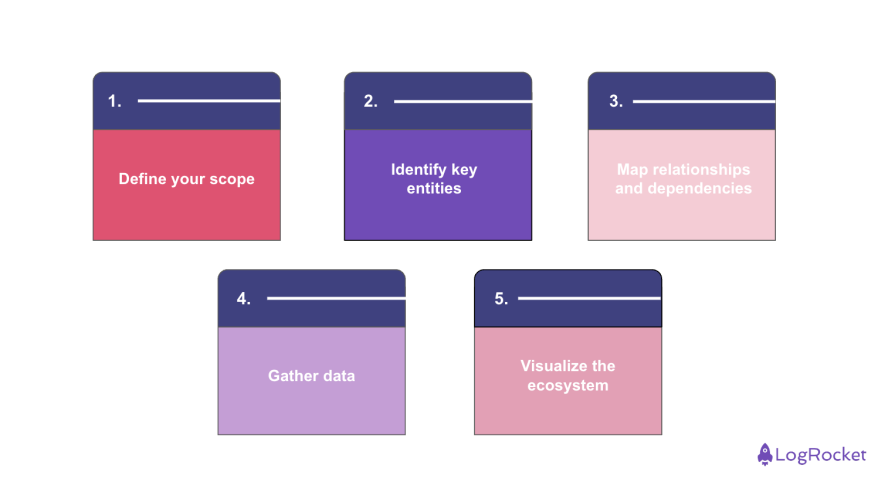As a product manager, you’re tasked with making decisions that balance market demands, customer needs, and internal resources. But without a clear view of the landscape that your product operates in, those decisions can feel like shots in the dark. That’s where ecosystem mapping comes in.

Ecosystem maps help you visualize the web of relationships and dependencies surrounding your product, from customers and competitors, to technologies and stakeholders. This tool offers clarity and foresight, enabling better planning, collaboration, and risk management.
Keep reading to learn what an ecosystem map is, its respective components, and how you can create one within your own product team.
An ecosystem map is a visual representation of all the key entities, like customers, partners, competitors, and technologies, that interact with your product. It also highlights the relationships between them and how these interactions influence the product’s development and success.
Ecosystem mapping is an essential practice that goes beyond understanding customer journeys. It enables a comprehensive view of the business, technology, and competitive environment, which is crucial for making informed strategic decisions. By clearly identifying these components, you can better prioritize product features, anticipate market shifts, and uncover collaboration opportunities.
At its core, an ecosystem map consists of three primary components:
There are also various types of ecosystem maps you can create based on what aspect of your product you’re focusing on:
An ecosystem map is much more than a diagram, it’s a strategic tool that enhances your ability to manage complexity and uncertainty. Here’s how:
As a leading music streaming platform, Spotify operates in a highly competitive environment with numerous stakeholders, including music labels, artists, advertisers, and users.
Spotify’s ecosystem map would include key entities such as:
By using an ecosystem map, Spotify can visualize the dependencies and relationships that directly influence its service offerings. This comprehensive view allows Spotify to prioritize new features (such as playlist recommendations or artist collaborations) while ensuring that critical partnerships (with music labels or third-party integrations) are maintained or strengthened.
This map also helps Spotify identify risks, such as over-dependence on a particular content provider or integration partner, and provides foresight into potential market shifts, like changes in user behavior or competition from other streaming platforms.
Building a useful ecosystem map takes a methodical approach. Here’s a step-by-step guide to get started:

What do you want to focus on — business, product, or technology? It’s important to start with a clear objective. For example, if you’re focusing on partnerships, create a business ecosystem map. If you’re analyzing dependencies within your development teams, a product ecosystem map might be more useful.
List out all the relevant players in the ecosystem — competitors, partners, customers, internal teams, and external stakeholders. Be thorough, as these are the building blocks of your map.
Once your entities are identified, connect them by drawing lines that represent relationships or dependencies. Think about how each entity interacts with the others. Do your features depend on a particular API? Does a partnership drive sales?
Use a combination of quantitative data (customer metrics, partner performance) and qualitative insights (team feedback, customer surveys) to ensure that your map reflects the real-world dynamics.
Structure your map for clarity, ensuring that anyone reviewing it can quickly grasp the relationships and dependencies. Group related entities together and use colors or labels to differentiate different types of relationships (e.g., direct vs. indirect influence).
There are several tools available to help product managers create and manage ecosystem maps effectively:
Each tool offers unique advantages, so choose based on your team’s needs, whether it’s real-time collaboration, integration with existing workflows, or ease of use.
Ecosystem mapping isn’t just a nice-to-have, it’s a strategic advantage. It provides a clear view of the complex interactions and dependencies surrounding your product, empowering you to make smarter, more informed decisions. From understanding market trends to prioritizing features, ecosystem maps offer a holistic perspective that can transform the way you manage your product’s development.
By incorporating ecosystem mapping into your product management toolkit, you’ll not only gain clarity but also drive better collaboration, identify risks before they become problems, and create a more effective roadmap for success.

LogRocket identifies friction points in the user experience so you can make informed decisions about product and design changes that must happen to hit your goals.
With LogRocket, you can understand the scope of the issues affecting your product and prioritize the changes that need to be made. LogRocket simplifies workflows by allowing Engineering, Product, UX, and Design teams to work from the same data as you, eliminating any confusion about what needs to be done.
Get your teams on the same page — try LogRocket today.

Most teams fail at autonomy. Learn how clear rules help product teams move faster without micromanagement.

A practical framework for PMs to use AI in ideation without sacrificing judgment, strategy, or decision quality.

A practical five minute revenue estimation method to help product managers compare ideas, drop low impact features, and prioritize smarter.

A practical guide for PMs who want to stop being bottlenecks, delegate smarter, and lead teams effectively with a clear ownership framework.